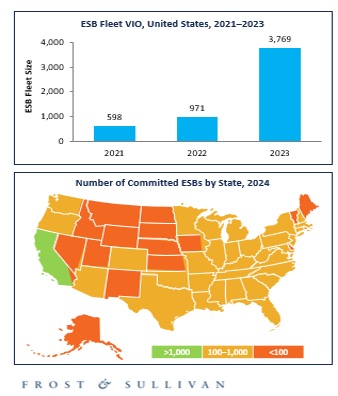Fleet electrification, reinforced by advanced technologies, will spotlight the advantages of DRT solutions over traditional school bus services.
Technological advancements and the increasing demand for sustainable, flexible, and efficient student transportation solutions are driving the North American school bus demand-responsive transport (DRT) market. Leveraging artificial intelligence (AI), telematics, and electrification, DRT is emerging as a viable alternative to traditional school bus operations that have long struggled with challenges such as driver shortages, inefficient route utilization, and rising safety expectations. As schools and districts seek smarter and greener transportation options, DRT solutions are offering enhanced efficiency, improved safety features, greater adaptability, and more cost-effective operations.
DRT Implementation will be Challenging
Despite its potential, the widespread deployment of school bus DRT services faces significant hurdles. Beyond addressing compatibility issues with legacy systems, schools and districts will also need to navigate data privacy concerns and cybersecurity risks. Additionally, route planning in DRT will be inherently complex since it requires accommodating diverse dynamics, including interacting with students of different age groups and varying mobility needs. Here, advanced AI-driven solutions will play an enabling role in realizing route efficiencies.
Driver shortages have long plagued the traditional school bus market. While DRT solutions offer automated scheduling and GPS-assisted navigation to ease the burden on drivers, specialized training is necessary to ensure drivers can efficiently manage dynamic routes. Furthermore, market expansion will be dependent on raising awareness among parents, school administrators, and policymakers about the multiple benefits of DRT.
Regulatory compliance presents a major challenge, requiring school bus DRT providers to adhere both to safety regulations as well as accessibility standards to accommodate students with disabilities. Financial constraints could also result in subdued adoption levels since schools and districts will need to factor in upfront investments in DRT technology as well as long-term operational costs. Here, government incentives and strategic partnerships will be critical in overcoming such financial barriers.
To learn more, please access: School Bus DRT Market, North America, 2023-2030, European and North American Mobility-as-a-Service Growth Opportunities, or contact sathyanarayanak@frost.com for information on a private briefing.
Electrification Emerges as a Major Trend
The transition to electrification is one of the most significant developments in the North American school bus DRT market. Government incentives and increasing environmental awareness are underpinning the appeal of electrified school bus fleets that not only reduce carbon emissions but also support lower, long-term operating costs. As policymakers push for greener transportation solutions, DRT operators that incorporate electric buses into their fleets will gain a competitive advantage.
AI-driven routing and real-time tracking are also transforming the industry. These technologies enable optimized route planning, reducing travel time and enhancing safety. By leveraging machine learning algorithms, DRT solutions can dynamically adjust routes based on real-time traffic data, student demand, and weather conditions. This flexibility is particularly beneficial in urban areas where traffic congestion and evolving school schedules require adaptive transportation models.
The demand for flexible, scalable transportation is further spurring DRT adoption. DRT systems can accommodate fluctuating student numbers and schedules; they allow schools to adjust routes and pick-up times in response to changing demand, reducing operational inefficiencies and improving resource allocation.
In the United States, the adoption of school bus DRT has been accelerated by supportive policies, advanced technology infrastructure, and a growing acceptance among schools, parents, and transport operators. Numerous start-ups have entered the market, introducing innovative business models and technology-driven solutions. On the other hand, Canada has seen slower adoption rates due to a less developed start-up ecosystem. However, as policy incentives expand and the need for cost-effective, flexible transport solutions increases, Canada presents significant growth opportunities for DRT providers.
Our Perspective
New business models are enhancing the scalability and adoption of school bus DRT solutions. Flexible subscription services and pay-per-use pricing structures are gaining traction, allowing schools to customize transportation solutions based on their specific needs. By offering tailored options such as part-time routes, accessibility-focused services, and dynamic scheduling, DRT providers can build diverse revenue streams, while reducing costs for schools and districts.
Meanwhile, advanced technologies will play a crucial role in optimizing operations and improving safety. AI-driven routing and real-time analytics will enable better route planning and enhanced cost and time efficiencies. The integration of predictive analytics and machine learning models will provide valuable insights to schools, municipalities, and transportation agencies, facilitating data-driven decision-making and improved services.
Safety and transparency features will continue to be a top priority for stakeholders. GPS tracking, driver authentication, and emergency response capabilities will enhance the user experience while positioning DRT as a safer alternative to traditional school buses. As schools demand greater visibility into transportation operations, DRT providers will need to prioritize real-time ride tracking, in-app communication, RFID student check-ins, onboard video monitoring, and automated safety reporting to meet expectations for transparency and security. Such features will foster trust among parents and school administrators.
Sustainability will remain a key priority in the evolution of school bus DRT. Electrification efforts, supported by government incentives and industry collaborations, will drive the adoption of green transport solutions. Partnerships between DRT operators, school bus manufacturers, and charging infrastructure providers will create a sustainable ecosystem for electric school bus fleets, offering services such as vehicle leasing, maintenance-inclusive contracts, and charging-as-a-service models.
Stakeholders that can align with the market’s key trends—electrification, AI-driven efficiency, and enhanced safety mechanisms—will be at the forefront of shaping the future of school transport in North America.
With inputs from Amrita Shetty, Senior Manager, Communications & Content – Mobility




